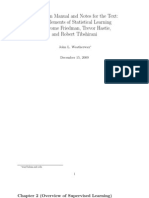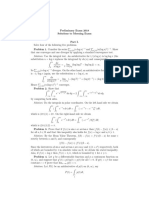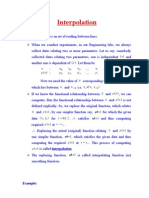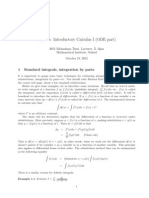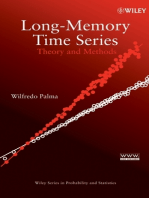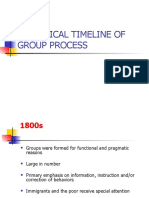Multivariate Normal Distribution: 3.1 Basic Properties
Multivariate Normal Distribution: 3.1 Basic Properties
Uploaded by
George WangCopyright:
Available Formats
Multivariate Normal Distribution: 3.1 Basic Properties
Multivariate Normal Distribution: 3.1 Basic Properties
Uploaded by
George WangOriginal Title
Copyright
Available Formats
Share this document
Did you find this document useful?
Is this content inappropriate?
Copyright:
Available Formats
Multivariate Normal Distribution: 3.1 Basic Properties
Multivariate Normal Distribution: 3.1 Basic Properties
Uploaded by
George WangCopyright:
Available Formats
3.
Multivariate Normal Distribution
The MVN distribution is a generalization of the univariate normal distribution which has the
density function (p.d.f.)
) (r) =
1
_
2o
exp
_
(r j)
2
2o
2
_
< r <
where j = mean of distribution, o
2
= variance. In jdimensions the density becomes
) (x) =
1
(2)
p=2
[[
1=2
exp
_
1
2
(x )
T
1
(x )
_
(3.1)
Within the mean vector there are j (independent) parameters and within the symmetric co-
variance matrix there are
1
2
j (j + 1) independent parameters [
1
2
j (j + 3) independent parameters
in total]. We use the notation
x s N
p
(; ) (3.2)
to denote a RV x having the jvariate MVN distribution with
E(x) =
Co (x) =
Note that MVN distributions are entirely characterized by the rst and second moments of the
distribution.
3.1 Basic properties
If x (j 1)is MVN with mean and covariance matrix
Any linear combination of x is MVN
Let y = Ax +c with A( j) and c ( 1) then
y s N
q
_
y
,
y
_
where
y
= A +c and
y
= AA
T
.
Any subset of variables in x has a MVN distribution.
If a set of variables is uncorrelated, then they are independently distributed. In particular
i) if o
ij
= 0 then r
i
, r
j
are independent.
1
ii) if x is MVN with covariance matrix , then Ax and Bx are independent if and only if
Co (Ax; Bx) = AB
T
(3.3)
= 0
Conditional distributions are MVN.
Result
For the MVN distribution, variable are uncorrelated = variable are independent.
Proof
Let x (j 1) be partitioned as
x =
_
x
1
x
2
_
j
with mean vector
=
_
2
_
j
and covariance matrix
j
=
_
11
12
21
22
_
j
i) Independent = uncorrelated (always holds).
Suppose x
1
, x
2
are independent. Then ) (x
1
, x
2
) = /(x
1
) q (x
2
) is a factorization of the
multivariate p.d.f.and
12
= Co (x
1
, x
2
) = E
_
(x
1
1
) (x
2
2
)
T
_
factorizes into the
product of E[(x
1
1
)] and E
_
(x
2
2
)
T
_
which are both zero since E(x
1
) =
1
and
E(x
2
) =
2
. Hence
12
= 0.
ii) Uncorrelated = independent (for MVN)
This result depends on factorizing the p.d.f. (3.1) when
12
= 0.
In this case (x )
T
1
(x ) has the partitioned form
_
x
T
1
T
1
, x
T
2
T
2
_
_
11
0
0
22
_
1
_
x
1
1
x
2
2
_
=
_
x
T
1
T
1
, x
T
2
T
2
_
_
1
11
0
0
1
22
__
x
1
1
x
2
2
_
= (x
1
1
)
T
1
11
(x
1
1
) + (x
2
2
)
T
1
22
(x
2
2
)
2
so that exp(x )
T
1
(x ) factorizes into the product of
exp
_
(x
1
1
)
T
1
11
(x
1
1
)
_
and exp
_
(x
2
2
)
T
1
22
(x
2
2
)
_
.
Therefore the p.d.f. can be written as
) (x) = q (x
1
) /(x
2
)
proving that x
1
and x
2
are independent.
3.2 Conditional distribution
Let X =
_
X
1
X
2
_
j
be a partitioned MVN random jvector,
with mean =
_
2
_
and covariance matrix
=
_
11
12
21
22
_
The conditional distribution of X
2
given X
1
= x
1
is MVN with
E(X
2
[X
1
= x
1
) =
2
+
21
1
11
(x
1
1
) (3.4a)
Co (X
2
[X
1
= x
1
) =
22
21
1
11
12
(3.4b)
Note: the notation X
1
to denote the r.. and x
1
to denote a specic constant value (realization
of X
1
) will be very useful here.
Proof of 3.4a
Dene a transformation from (X
1
, X
2
) to new variables X
1
and X
0
2
= X
2
21
1
11
X
1
.
Note that this can be achieved by the linear transformation
_
X
1
X
0
2
_
=
_
I 0
21
1
11
I
__
X
1
X
2
_
(3.5a)
Y = AX say. (3.5b)
This linear relationship shows that X
1
, X
0
2
are jointly MVN (by rst property of MVN stated
above.)
We now show that X
0
2
and X
1
are independent by proving that X
1
and X
0
2
are uncorrelated.
3
Co
_
X
1
, X
0
2
_
= Co
_
X
1
, X
2
21
1
11
X
1
_
= Co(X
1
, X
2
) Co (X
1
, X
1
)
1
11
12
=
12
11
1
11
12
= 0
Note also that in (3.3), we may write
A =
_
B
C
_
where B =
_
I 0
_
and C =
_
21
1
11
I
_
Hence again we see that
Co
_
X
1
, X
0
2
_
= Co (BX; CX)
= BC
T
=
_
I 0
_
_
11
12
21
22
__
1
11
12
I
_
=
_
11
12
_
_
1
11
12
I
_
= 0
Since X
0
2
and X
1
are MVN and uncorrelated they are independent. Thus
E
_
X
0
2
[X
1
= x
1
_
= E
_
X
0
2
_
= E
_
X
2
21
1
11
X
1
_
=
2
21
1
11
1
Now, as X
0
2
= X
2
21
1
11
X
1
and X
1
= x
1
is given, we have
E(X
2
[X
1
= x
1
) = E
_
X
0
2
[X
1
= x
1
_
+
21
1
11
x
1
=
2
21
1
11
1
+
21
1
11
x
1
=
2
+
21
1
11
(x
1
1
)
as required.
Proof of 3.4b
Because X
0
2
is independent of X
1
Co
_
X
0
2
[X
1
= x
1
_
= Co
_
X
0
2
_
4
The left hand side is
1Ho = Co
_
X
0
2
[X
1
= x
1
_
= Co
_
X
2
21
1
11
x
1
[X
1
= x
1
_
= Co (X
2
[X
1
= x
1
)
The right hand side is
1Ho = Co
_
X
0
2
_
= Co
_
X
2
21
1
11
X
1
_
=
22
21
1
11
12
following from the general expansion
Co (X
2
DX
1
) = Co (X
2
, X
2
) DCo (X
1
, X
2
)
Co (X
2
, X
1
) D
T
+DCo (X
1
, X
1
) D
T
with D =
21
1
11
. Therefore
Co (X
2
[X
1
= x
1
) =
22
21
1
11
12
as required.
Example
Let x have a MVN distribution with covariance matrix
=
_
_
1 j j
2
j 1 0
j
2
0 1
_
_
Show that the conditional distribution of (A
1
, A
2
) given A
3
= r
3
is also MVN with mean
=
_
j
1
+j
2
(r
3
j
3
)
j
2
_
and covariance matrix
_
1 j
4
j
j 1
_
5
Solution
Let Y
1
=
_
A
1
A
2
_
and Y
2
= (A
3
) then
EY
1
=
_
j
1
j
2
_
EY
2
= (j
3
) .
We have Co
_
Y
1
Y
2
_
=
_
11
12
21
22
_
where
11
=
_
1 j
j 1
_
12
=
_
j
2
0
_
=
T
21
22
= [1]
Hence
E[Y
1
[Y
2
= r
3
] =
1
+
12
1
22
(r
3
j
3
)
=
_
j
1
j
2
_
+
_
j
2
0
_
(x
3
3
)
=
_
j
1
+j
2
(r
3
j
3
)
j
2
_
and .
Co [Y
1
[Y
2
= r
3
] =
11
12
1
22
21
=
_
1 j
j 1
_
_
j
2
0
_
_
j
2
0
_
=
_
1 j
4
j
j 1
_
3.3 Maximum-likelihood estimation
Let X
T
= (x
1
, ..., x
n
) contain an independent random sample of size : from
p
(; ) .
The maximum likelihood estimates (MLE s) of , are the sample mean and covariance matrix
(with divisor :)
^ = x (3.6a)
^
= S (3.6b)
6
The likelihood function is a function of the parameters ; given the data X
1(; jX) =
n
r=1
) (x
r
[; ) (3.7)
The RHS is evaluated by substituting the individual data vectors x
1
, ..., x
n
in turn into the
p.d.f. of
p
(; ) and taking the product.
n
r=1
) (x
r
[; ) = (2)
np
2
jj
n=2
exp
_
1
2
n
r=1
(x
r
)
T
1
(x
r
)
_
Maximizing 1 is equivalent to minimizing the "log likelihood" function
| (; ) = 2 log 1
= 2
n
r=1
log ) (x
r
[; )
= 1 +:log jj+
n
r=1
(x
r
)
T
1
(x
r
) (3.8)
where 1 is a constant independent of ; :
Result 3.3
| (; ) = :
_
log [ j+tr
_
1
_
S +dd
T
__
(3.9)
up to an additive constant, where d = x :
Proof
Noting that x
r
= (x
r
x) +d the nal term in the likelihood expression (3.8) becomes
n
r=1
(x
r
)
T
1
(x
r
)
=
n
r=1
(x
r
x)
T
1
(x
r
x) +:d
T
1
d
= :tr
_
1
S
_
+:d
T
1
d
= :tr
_
1
_
S +dd
T
_
proving the expression (3.9). Note that the cross-product terms have vanished because
n
r=1
x
r
=
7
: x and therefore
n
r=1
d
T
1
(x
r
x) = d
T
1
n
r=1
(x
r
x)
=
n
r=1
(x
r
x)
T
1
d
= 0
In (3.9) the dependence on is entirely through d. Now assume that is positive denite (p.d.),
then so is
1
as
1
= V
1
V
T
where = V V
T
is the eigenanalysis of . Thus \d 6= 0 we have d
T
1
d > 0. Hence | (; )
is minimized with respect to for xed when d = 0 i.e.
^ = x
Final part of proof: to minimize the log-likelihood | (^ ; ) w.r.t. let
| (^ ; ) = :
_
log [[ +tr
_
1
S
__
= () , , say (3.10)
We show that S minimizes () by proving that (S) _ () , \
() (S) = :
_
log [[ log [S[ +tr
_
1
S
_
j
_
= :
_
tr
_
1
S
_
log [
1
S[ j
_
(3.11)
_ 0
Lemma 1
1
S is positive semi-denite (proved elsewhere). Therefore the eigenvalues of
1
S are
positive.
Lemma 2
For any set of positive numbers
_ log G+ 1
where and G are the arithmetic, geometric means respectively.
Proof
8
For all r we have c
x
_ 1 +r (simple exercise).Consider a set of : strictly positive numbers j
i
j
i
_ 1 + log j
i
j
i
_ : +
log j
i
_ 1 + log
_
j
i
_1
n
= 1 + log G
as required.
Recall that for any (: :) matrix A; we have tr (A) =
n
i=1
`
i
the sum of the eigenvalues,
and [ Aj =
`
i
the product of the eigenvalues. Let `
i
(i = 1, ..., j) be the positive eigenvalues of
1
S and substitute in (3.11)
log [
1
S[ = log
_
`
i
_
= j log G
tr
_
1
S
_
=
`
i
= j
Hence
() (S) = :j log G1
_ 0
This proves that the MLEs are as stated in (3.6) .
3.3 Sampling distribution of x and S
3.3.1 The Wishart distribution (Denition)
If M (j j) can be written M = X
T
X where X (:j) is a data matrix from
p
(0, ) then
M is said to have a Wishart distribution with scale matrix and degrees of freedom :. We write
M s \
p
(;:) (3.12)
When = I
p
the distribution is said to be in standard form.
Note:
The Wishart distribution is the multivariate generalization of the chi-square
2
distribution
9
Additive property of matrices with a Wishart distribution
Let M
1
, M
2
be matrices having the Wishart distribution
M
1
s \
p
(;:
1
)
M
2
s \
p
(;:
2
)
independently, then
M
1
+M
2
s \
p
(;:
1
+:
2
)
This property follows from the denition of the Wishart distribution because data matrices are
additive in the sense that if
X =
_
X
1
X
2
_
is a combined data matrix consisting of :
1
+:
2
rows then
X
T
X = X
T
1
X
1
+X
T
2
X
2
is matrix (known as the "Gram matrix") formed from the combined data matrix X:
Case of j = 1
When j = 1 we know from the denition of
2
r
as the distribution of the sum of squares of r
independent (0, 1) variates that if A
i
~
_
0, o
2
_
then
M =
m
i=1
A
2
i
s o
2
2
m
so that
\
1
_
o
2
, :
_
= o
2
2
m
3.3.2 Sampling distributions
Let x
1
, x
2
, ..., x
n
be a random sample of size : from
p
(, ). Then
1. The sample mean x has the normal distribution
x s
p
_
,
1
:
_
2. The (scaled) sample covariance matrix has the Wishart distribution:
(: 1) S
u
s \
p
(;: 1)
3. The distributions of x and S
u
are independent.
10
3.4 Estimators for special circumstances
3.4.1 j proportional to a given vector
Sometimes is known to be proportional to a given vector, so = /
0
with
0
being a known
vector.
For example if x represents a sample of repeated measurements then = /1where 1 =
(1, 1, ..., 1)
T
is the jvector of 1
0
:.
We nd the MLE of / for this situation. Suppose is known and = /
0
. Let d
0
= x/
0
.
The log likelihood is
| (/) = 2 log 1
= :
_
log [ j+ tr
_
1
_
S +d
0
d
T
0
__
= :
_
log [ j+ tr
_
1
S
_
+ ( x/
0
)
T
1
( x/
0
)
_
= :
_
x
T
1
x2/
T
0
1
x+/
2
T
0
+ constant terms indept of /
Set
d|
d/
= 0 to minimize | (/) w.r.t. /
2
T
0
1
x+2
_
T
0
0
_
/ = 0
from which
^
/ =
T
0
1
x
T
0
0
(3.13)
Properties
We now show that
^
/ is an unbiased estimator of / and determine the variance of
^
/
In (3.13)
^
/ takes the form
1
c
c
T
x with c
T
=
T
0
1
and c =
T
0
0
so
E
_
^
/
_
=
c
T
E[ x]
c
=
/c
T
0
c
.
=
/
T
0
0
c
since E[ x] = /
0
. Hence
E
_
^
/
_
= / (3.14)
showing that
^
/ is an unbiased estimator.
11
Note that \ ar [ x] =
1
:
and therefore that \ ar
_
c
T
x
=
1
:
c
T
c we have
\ ar
_
^
/
_
=
1
:c
2
c
T
c
=
1
:
T
0
0
_
T
0
0
_
2
=
1
:
T
0
0
(3.15)
3.4.2 Linear restriction on j
We determine an estimator for to satisfy a linear restriction
A = b
where A (:j) and b (:1) are given constants and is assumed to be known.
We write the restriction in vector form g () = 0 and form the Lagrangean
/(; ) = | () + 2
T
g ()
where
T
= (`
1
, ..., `
m
) is a vector of Lagrange multipliers (the factor 2 is inserted just for
convenience).
/(; ) = | () + 2
T
(A b)
= :
_
( x )
T
1
( x ) + 2
T
(A b)
_
ignore constant terms involving
Set
d
d
/(; ) = 0 using results from Example Sheet 2:
2
1
( x ) + 2A
T
= 0
x = A
T
(3.16)
We use the constraint A = b to evaluate the Lagrange multipliers : Premultiply by A
A x b = AA
T
=
_
AA
T
_
1
(A x b)
Substitute into (3.16)
^ = x A
T
_
AA
T
_
1
(A x b) (3.17)
12
3.4.3 Covariance matrix proportional to a given matrix
We consider estimating / when = /
0
, where
0
is a given.constant matrix. The likelihood
(3.8) takes the form when d = 0 (^ = x)
| (/) = :
_
log [/
0
[ +tr
_
1
/
1
0
S
__
plus constant terms (not involving /).
| (/) =
_
j log / +
1
/
tr
_
1
0
S
_
_
+ constant terms
d|
d/
= 0 =
j
/
1
/
2
tr
_
1
0
S
_
= 0
Hence
^
/ =
tr
_
1
0
S
_
j
(3.18)
13
You might also like
- Solutions To Steven Kay's Statistical Estimation BookDocument16 pagesSolutions To Steven Kay's Statistical Estimation Bookmasoudsmart67% (3)
- Effects of Social Media On Interpersonal Relationship Among Undergraduate StudentsDocument13 pagesEffects of Social Media On Interpersonal Relationship Among Undergraduate StudentsOderinde Oluwaseyi83% (6)
- Useful Swahili WordsDocument4 pagesUseful Swahili WordsBlackQ100% (3)
- Euphentisation As A Politeness Strategy in Arabic Screen Translation, With A Special Roý, Rence To 'Friends'Document243 pagesEuphentisation As A Politeness Strategy in Arabic Screen Translation, With A Special Roý, Rence To 'Friends'Mansour altobiNo ratings yet
- Multivariate Normal Distribution: 3.1 Basic PropertiesDocument13 pagesMultivariate Normal Distribution: 3.1 Basic PropertiesApam BenjaminNo ratings yet
- Lecture 09Document15 pagesLecture 09nandish mehtaNo ratings yet
- 1.10 Two-Dimensional Random Variables: Chapter 1. Elements of Probability Distribution TheoryDocument13 pages1.10 Two-Dimensional Random Variables: Chapter 1. Elements of Probability Distribution TheoryAllen ChandlerNo ratings yet
- Midterm One 6711 F10 SolsDocument8 pagesMidterm One 6711 F10 SolsSongya PanNo ratings yet
- 3 Discrete Random Variables and Probability DistributionsDocument26 pages3 Discrete Random Variables and Probability DistributionsRenukadevi RptNo ratings yet
- Chapter 6F-PropCRV - W PDFDocument30 pagesChapter 6F-PropCRV - W PDFaltwirqiNo ratings yet
- Weather Wax Hastie Solutions ManualDocument18 pagesWeather Wax Hastie Solutions ManualdaselknamNo ratings yet
- Chapter Three Metrics (I)Document35 pagesChapter Three Metrics (I)negussie birieNo ratings yet
- Chapter Four: Bivariate Distribution Theory: Example 1Document8 pagesChapter Four: Bivariate Distribution Theory: Example 1Kimondo KingNo ratings yet
- Misc Matrix AlgebraDocument8 pagesMisc Matrix AlgebraRenukha PannalaNo ratings yet
- TFY4305 Solutions Exercise Set 1 2014: Problem 2.2.3Document4 pagesTFY4305 Solutions Exercise Set 1 2014: Problem 2.2.3Abu Bakar SiddiqueNo ratings yet
- PRP NotesDocument10 pagesPRP NotesBharath JojoNo ratings yet
- 3 Discrete Random Variables and Probability DistributionsDocument22 pages3 Discrete Random Variables and Probability DistributionsTayyab ZafarNo ratings yet
- Econometrics Chapter ThreeDocument35 pagesEconometrics Chapter Threeyihun0521No ratings yet
- Sta 204 Lecture 5Document17 pagesSta 204 Lecture 5adeyemianointed2021No ratings yet
- Digital CommunicationDocument8 pagesDigital CommunicationShulav PoudelNo ratings yet
- Linear AlgebraDocument6 pagesLinear AlgebraPeterNo ratings yet
- Lecture 2 Calculus of Multi Variables 2011Document22 pagesLecture 2 Calculus of Multi Variables 2011Yiauw ShenqNo ratings yet
- Chapter 5Document19 pagesChapter 5chilledkarthikNo ratings yet
- Class - Test 2 SolnDocument5 pagesClass - Test 2 SolniitkgpdelNo ratings yet
- Multi Varia Da 1Document59 pagesMulti Varia Da 1pereiraomarNo ratings yet
- Group 1 - HW1 - SMCDocument7 pagesGroup 1 - HW1 - SMCyazen.shakirNo ratings yet
- Formal Definitons of LimitsDocument11 pagesFormal Definitons of LimitsAnubhav SwaroopNo ratings yet
- Random Variables IncompleteDocument10 pagesRandom Variables IncompleteHamza NiazNo ratings yet
- Stat331-Multiple Linear RegressionDocument13 pagesStat331-Multiple Linear RegressionSamantha YuNo ratings yet
- Solutions 01Document10 pagesSolutions 01patyNo ratings yet
- 13 2 Definite IntegralsDocument10 pages13 2 Definite IntegralsDaniel SolhNo ratings yet
- Multivariate Normal DistributionDocument9 pagesMultivariate Normal DistributionccffffNo ratings yet
- Chi-Square and F DistributionDocument18 pagesChi-Square and F DistributionSapna MeenaNo ratings yet
- Discrete Probability DistributionDocument5 pagesDiscrete Probability DistributionAlaa FaroukNo ratings yet
- DifferentiationDocument44 pagesDifferentiationnaseem113No ratings yet
- Exam P Formula SheetDocument14 pagesExam P Formula SheetToni Thompson100% (4)
- Review of Random VariablesDocument8 pagesReview of Random Variableselifeet123No ratings yet
- CHAPTER 04-Random VariableDocument37 pagesCHAPTER 04-Random VariableHaniNo ratings yet
- 2 KNVKSDVDocument5 pages2 KNVKSDVTeal TealyNo ratings yet
- Principal Components Analysis (PCA) : 2.1 Outline of TechniqueDocument21 pagesPrincipal Components Analysis (PCA) : 2.1 Outline of TechniqueGeorge WangNo ratings yet
- Improper IntegralDocument23 pagesImproper IntegralPblock Saher100% (1)
- Practice Quiz 2: Daniel Seleznev March 2014Document4 pagesPractice Quiz 2: Daniel Seleznev March 2014George TreacyNo ratings yet
- OptimalLinearFilters PDFDocument107 pagesOptimalLinearFilters PDFAbdalmoedAlaiashyNo ratings yet
- 316s Answer10 PDFDocument3 pages316s Answer10 PDFjisteeleNo ratings yet
- 12 International Mathematics Competition For University StudentsDocument4 pages12 International Mathematics Competition For University StudentsMuhammad Al KahfiNo ratings yet
- MATH21Document11 pagesMATH21NilushaNo ratings yet
- Curve Interpolation. Newton's Divided Differences. Lagrange PolynomialsDocument4 pagesCurve Interpolation. Newton's Divided Differences. Lagrange PolynomialsAhmet GelisliNo ratings yet
- RandomVari_2Document3 pagesRandomVari_2santhiyathasarajNo ratings yet
- Conformal Field NotesDocument7 pagesConformal Field NotesSrivatsan BalakrishnanNo ratings yet
- Anasol 2018Document6 pagesAnasol 2018Atoloye Habeeb OlawaleNo ratings yet
- Hw1sol PDFDocument9 pagesHw1sol PDFRohit BhadauriaNo ratings yet
- Sta227 NotesDocument82 pagesSta227 Notes001亗PRÍËšT亗No ratings yet
- Mathphysc2sol 12 PDFDocument14 pagesMathphysc2sol 12 PDFFuat YıldızNo ratings yet
- Appendix: Physical Constants and Mathematical RelationsDocument9 pagesAppendix: Physical Constants and Mathematical RelationsMarta HenriquesNo ratings yet
- FAC Sample 2010Document6 pagesFAC Sample 2010aslam844No ratings yet
- CH 3Document22 pagesCH 3Agam Reddy MNo ratings yet
- Math511 HW4 PDFDocument4 pagesMath511 HW4 PDFMRNo ratings yet
- InterpolationDocument7 pagesInterpolationNivi SenthilNo ratings yet
- Single - Random - VariableDocument13 pagesSingle - Random - Variableiha8leNo ratings yet
- Prelims Introductory Calculus 2012MTDocument22 pagesPrelims Introductory Calculus 2012MTMaoseNo ratings yet
- Mathematics 1St First Order Linear Differential Equations 2Nd Second Order Linear Differential Equations Laplace Fourier Bessel MathematicsFrom EverandMathematics 1St First Order Linear Differential Equations 2Nd Second Order Linear Differential Equations Laplace Fourier Bessel MathematicsNo ratings yet
- Student's Solutions Manual and Supplementary Materials for Econometric Analysis of Cross Section and Panel Data, second editionFrom EverandStudent's Solutions Manual and Supplementary Materials for Econometric Analysis of Cross Section and Panel Data, second editionNo ratings yet
- Distance-Based TechniquesDocument7 pagesDistance-Based TechniquesGeorge WangNo ratings yet
- Hypothesis Testing (Hotelling's T - Statistic) : 4.1 The Union-Intersection PrincipleDocument19 pagesHypothesis Testing (Hotelling's T - Statistic) : 4.1 The Union-Intersection PrincipleGeorge WangNo ratings yet
- Principal Components Analysis (PCA) : 2.1 Outline of TechniqueDocument21 pagesPrincipal Components Analysis (PCA) : 2.1 Outline of TechniqueGeorge WangNo ratings yet
- MVA Section1 2012Document14 pagesMVA Section1 2012George WangNo ratings yet
- Discriminant Analysis: 5.1 The Maximum Likelihood (ML) RuleDocument6 pagesDiscriminant Analysis: 5.1 The Maximum Likelihood (ML) RuleGeorge WangNo ratings yet
- Geng, Hwaiyu (2004), Manufacturing Engineering Handbook - QFDDocument6 pagesGeng, Hwaiyu (2004), Manufacturing Engineering Handbook - QFDCristina ZavalaNo ratings yet
- Charli and The Chocolate FactoryDocument16 pagesCharli and The Chocolate FactoryGhada AhmedNo ratings yet
- 34 Tla Mumbai June2015Document269 pages34 Tla Mumbai June2015kalyan.thakur02No ratings yet
- Usp GC 800Document20 pagesUsp GC 800Majid Hamidi DadgarNo ratings yet
- Swot Rationale For A Semester SystemDocument6 pagesSwot Rationale For A Semester Systemkharemix0% (1)
- Grade 10 Third Quarter Test QuestionDocument2 pagesGrade 10 Third Quarter Test Questionjhun bagain75% (4)
- TALKING ELECTRONICS 555 Page1Document11 pagesTALKING ELECTRONICS 555 Page1Eugene FlexNo ratings yet
- The Debated Mind Evolutionary Psychology Versus EthnographyDocument238 pagesThe Debated Mind Evolutionary Psychology Versus EthnographyMarlene TavaresNo ratings yet
- Kanban SizingDocument102 pagesKanban Sizingsribalaji22No ratings yet
- Lesson 6 Problem Set: Nys Common Core Mathematics CurriculumDocument2 pagesLesson 6 Problem Set: Nys Common Core Mathematics CurriculumNurdamia InsyirahNo ratings yet
- RS Sharma Volume PDFDocument21 pagesRS Sharma Volume PDFanamika0% (1)
- 9FM0 Topic Test - CP - 1 - Proof by Induction MS PDFDocument15 pages9FM0 Topic Test - CP - 1 - Proof by Induction MS PDFpriyahaasinigantiNo ratings yet
- 1 PlanningDocument21 pages1 PlanningGloria Lambo GillacoNo ratings yet
- Surgery EntranceDocument352 pagesSurgery EntranceDipesh Shrestha100% (1)
- SIRE - Tablet-Based InspectionsDocument5 pagesSIRE - Tablet-Based InspectionsLaiqNo ratings yet
- ENG CV ChaimaDocument2 pagesENG CV Chaimag4g49mqbf8No ratings yet
- Introduction To Cuisine of The WorldDocument8 pagesIntroduction To Cuisine of The WorldJayeelleNo ratings yet
- Historical Timeline of Group ProcessDocument25 pagesHistorical Timeline of Group Processmoises deasisNo ratings yet
- Pigeonhole Principle FinalDocument73 pagesPigeonhole Principle FinalVicky Feliciano100% (3)
- 1st Q. - PT in Science 5Document7 pages1st Q. - PT in Science 5reynalyn suangcoNo ratings yet
- Software Requirements Specification: Exam EarnDocument22 pagesSoftware Requirements Specification: Exam EarnGurjyot SinghNo ratings yet
- Studies of Animal BehaviorDocument22 pagesStudies of Animal BehaviorSAKSHI MORENo ratings yet
- Mutual FundDocument61 pagesMutual FundYogendra AmbadeNo ratings yet
- K-Patents Flow Calculator (Metric) : Flow Rate Q 10 m3/h 166.7 L/min 44.0 GPMDocument2 pagesK-Patents Flow Calculator (Metric) : Flow Rate Q 10 m3/h 166.7 L/min 44.0 GPMArmend AvdiuNo ratings yet
- Swapnil ResumeDocument3 pagesSwapnil Resumearpita_vermaNo ratings yet
- Kilrain 1113 EssayDocument5 pagesKilrain 1113 Essayapi-409530890No ratings yet
- Micro Brewing Guide EnglishDocument27 pagesMicro Brewing Guide EnglishZamir HadesNo ratings yet










